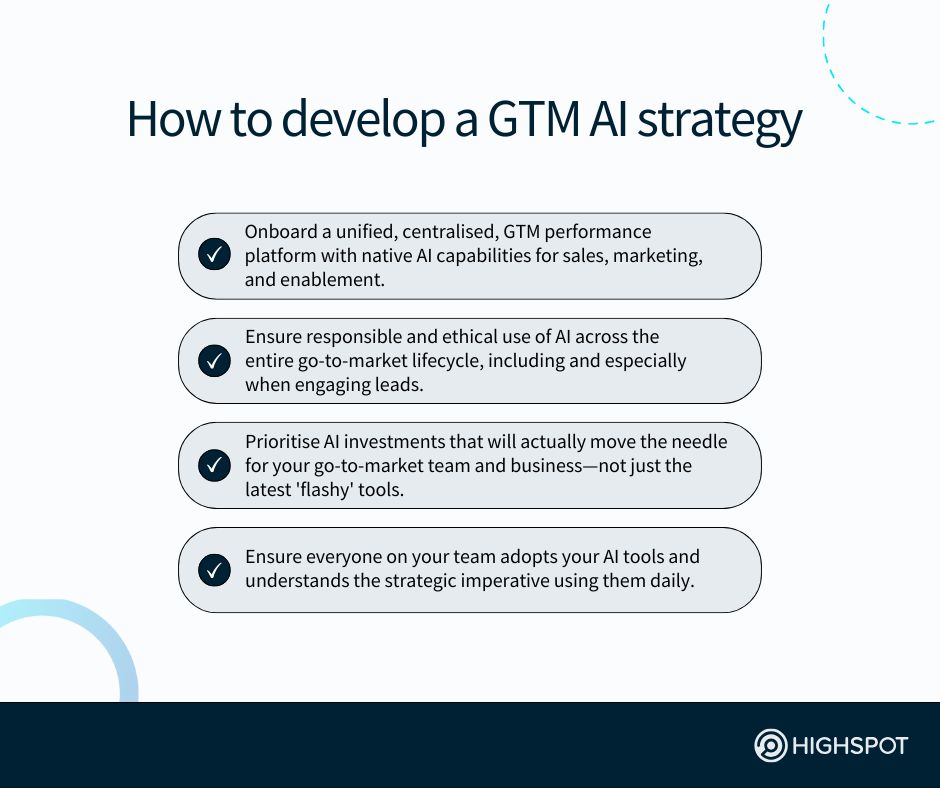Key Insights:
- Deciding your go-to-market (GTM) team must leverage artificial intelligence is one thing. Establishing defined practices for use of the tech and assessing where your organisation stands on the AI maturity model is another.
- Per Highspot’s 2025 GTM Performance Gap Report, few enterprise go-to-market leaders are effectively operationalising AI, preventing them from achieving their sales and marketing ROI and contributing to revenue growth.
- Measuring AI maturity enables go-to-market leaders such as yourself to rectify performance issues tied to use of artificial intelligence tools and define best practices for ongoing utilisation of the emerging technology.
“How can we better use AI to automate workflows and accelerate growth?”
If you’re in sales or revenue leadership, you’ve probably heard this question from your CEO at every QBR in the last couple years. And, if we’re being honest—it’s a fair one.
You’re under pressure to execute. Budgets are tight. Targets are high. Every go-to-market (GTM) team—sales, marketing, and enablement—is being asked to do more with less.
Because of this, everyone in GTM is looking to AI for any kind of competitive edge.
But knowing where to start—or how to go further—with AI isn’t always obvious.
Cutting-edge AI is already showing up across your organisation (in and outside GTM), whether through tools that surface insights, streamline processes, or generate content.
That being said, implementing AI and optimising AI are two very different things.
That makes knowing where your go-to-market function currently stands on the AI maturity model—and what it takes to advance to the next ‘level’—absolutely essential.
The AI maturity model, explained
At its core, AI maturity isn’t about how many tools you’ve purchased or deployed.
Rather, it’s about how deeply AI is integrated into your business processes—and whether it’s actually helping you achieve improved business outcomes and operational excellence in all facets of GTM operations:
- Do you simply react to data, or do you turn insights into winning actions at scale?
- Are your GTM team’s AI investments creating new value, or just more dashboards?
- Have sales, marketing, and enablement embraced AI, or do they use it sparingly?
The truth is many enterprise GTM teams like yours are stuck somewhere in between.
You might have invested in promising AI capabilities, but gaps remain—between insight and action, siloed tools and connected execution, and potential and real progress.
And when that gap shows up in your frontline, where you engage directly with customers, so does inconsistent messaging, missed opportunities, and sluggish growth.
This is why a clear and calculated AI strategy matters now more than ever for GTM.
- Without such a strategy—one factoring in your C-suite’s input and business goals—AI becomes just another thing to manage, not a force multiplier for performance.
- With such a strategy, you can empower every GTM team to make smarter decisions, move faster, and drive outcomes that ladder up to critical business objectives.
That’s what Highspot’s GTM Performance Gap Report is all about—shedding light on how leading organisations are using AI not just to automate, but to innovate. Not just to collect more data, but to activate it across their go-to-market engine.
GTM Performance Report insights
Many of the go-to-market leaders we recently surveyed said they recognise the strategic imperative of elevating their AI maturity level and reap the benefits in the form of faster decision-making, better alignment, and a future-ready GTM motion.
Yet, data from our report shows these GTM organisations just aren’t there yet:
- Just 28% of sales, marketing, enablement, and revenue leaders polled said AI maturity is a “core driver” of GTM performance for their companies.
- More than three in five (62%) of GTM leaders’ organizations are still operating at a low-to-mid AI maturity level, despite a concerted effort to grow.
- Data management and security concerns, insufficient budget, internal resistance, and leadership skepticism are preventing many of their GTM teams from moving beyond their current capabilities and fully embracing the use of AI.
“The problem isn’t a lack of effort,” according to the report. “It’s a lack of alignment.”
If you want to avoid this kind of AI innovation inertia, then the tasks at hand are clear:
- Assess where your organisation resides on the AI maturity model today.
- Gain the necessary buy-in in-house for onboarding new AI technologies.
- Establish a roadmap for your AI journey over the next few years (at least).
- Work cross-functionally to establish a clear AI strategy for your business.
- Integrate AI into your company’s day-to-day marketing and sales operations.
To reiterate, though: Advancing AI maturity starts with measuring AI maturity, and you can only do that with the right solutions in your go-to-market technology stack—notably, with a GTM enablement platform that has a native AI and analytics engine.

Developing a go-to-market AI strategy
Countless B2B organisations that have adopted AI have seen marked growth from its (mostly) seamless incorporation in core workflows and business operations.
Yet, a 2025 Bain & Company Commercial Excellence Survey found that not every company is seeing the desired return on investment from new AI initiatives.
“For all the benefits B2B companies have seen, some AI programs are falling short,” per Bain’s study. “Roughly a quarter of respondents’ sales and marketing AI pilots have failed, and among the AI use cases in pilot phase, roughly one-fifth are not meeting expectations.”
The lesson: Today’s AI “winners,” as the report refers to them, don’t always have high AI maturity out of the gate. These businesses need time to master AI technologies added to their ecosystems and ensure business processes and practices are adjusted accordingly to truly capitalise on enterprise-level AI tools.
As our GTM performance gap report alludes to, there are a few key steps your GTM can follow to increase your AI maturity and avoid any onboarding, implementation, or adoption issues that prevent your GTM team from improving key sales performance metrics.
Onboard a top go-to-market performance platform
To get meaningful value from artificial intelligence, you need a unified foundation that powers clarity, consistency, and impact across teams.
Onboarding a GTM performance platform with purpose-built, advanced, easy-to-use AI capabilities that span sales, marketing, and enablement ensures each team moves in lockstep as they tackle product launches and other shared initiatives.
With AI working in the background of our enablement software, GTM teams with our platform can surface just-in-time guidance for their sales reps that’s personalised and actionable—no toggling between tools, no missed moments.
What’s more, direct integration with Salesforce enables Highspot Agents to deliver insights right where your GTM teams work, driving smarter execution and sales and operations planning—all without disruption.
Some notable GTM performance platform capabilities that help boost AI maturity include:
- AI insights spoken on calls, shared in content, and shown in buyers’ behaviours
- Support and services to help your sales team move from setup to value quickly
- Customisable, AI-powered workflows to aid with sales training and coaching
Simply put, your AI initiatives are greatly enhanced with an enablement solution guiding your entire go-to-market team from early-stage prospecting to late-stage objection-handling.
Ensure responsible AI use and data management
Of course, AI adoption is no guarantee of GTM success—especially without a clear data-governance framework in place, with a focus on data quality and compliance.
Ethical AI use starts with ensuring your models—proprietary or offered by your enablement platform—are trained on the right information and align with business goals.
Your organisation must assess data quality early and often. ‘Garbage in, garbage out’ is particularly critical when leveraging AI technologies for GTM use cases.
By embedding responsible practices in your go-to-market team now, you protect your business, customers, and workforce from risks that grow with adopting AI.
Put another way? Your AI-powered insights only work if the underlying data is accurate, timely, and contextual—across sales, marketing, and enablement initiatives.
To meet evolving business expectations, enhance customer experiences, and ensure effective decision-making within your go-to-market strategy, your enterprise’s AI strategy must be grounded in ethics, privacy, and compliance.
Prioritise AI investments that will influence revenue
The Highspot GTM Performance Gap Report found nearly two-thirds (64%) of go-to-market leaders across the globe either have just some, little, or no idea behind how misalignment has negatively impacted their revenue goals.
Not every AI tool will have direct improvements or influence on your revenue.
However, the right AI technology ecosystem can collectively drive measurable outcomes across pipeline creation, win rates, and deal velocity for your business.
Translation: Determine your needs regarding AI in sales and marketing, then evaluate the go-to-market technology landscape to figure out which AI software can:
- Streamline daily business processes related to your respective GTM motion
- Empower your sales reps to show up smarter in their buyer engagement efforts
- Tell your marketers what content-related activities to ditch and double down on
- Inform your sales enablement team on how they can scale strategies that work
- At the end of the day, help advance your organisation’s AI maturity level
Just as other business units across your workforce—from HR and finance, to IT and engineering—need AI technology to improve their business practices, workflows, and metrics, your GTM function must discern which AI solutions and capabilities offer the most value, as it relates to better and faster decision-making.
Any tool that doesn’t help in this regard is likely not worth the investment—or a platform that can help you upgrade your go-to-market organisation’s AI maturity level.
Get 100% AI adoption across your entire GTM team
Ensuring AI adoption doesn’t just happen because you’ve invested in AI.
Your strategy must align with how your GTM team works and what in-the-moment info they need to make progress, whether that’s engaging potential customers in a more timely and intelligent manner or tapping into AI-powered insights that identify current enablement gaps and future sales content opportunities.
“The teams winning today aren’t rushing to deploy,” per our go-to-market performance report. “They’re choosing informed AI that delivers the right insights, context, and expertise—AI that’s embedded in their GTM motion.”
Similarly, training your teams on the use of AI for GTM isn’t enough.
You also need embedded tools that feel like a natural part of their workflow—not another intricate AI technology platform they have to learn and master to execute efficiently.
Here’s a helpful piece of advice for evaluating solutions that can elevate your AI maturity level: The most effective AI is invisible. In other words, it’s personalised, timely, and aligned with team priorities, offering the help you need exactly when you need it.
By investing in AI that can be effortlessly integrated in your GTM tech environment and is role-specific, your organisation can ensure use of the tools becomes second nature—utilised by everyone, every day, to achieve progress and deliver better results.
How to improve your artificial intelligence maturity level
It’s hard for anyone, let alone GTM leaders such as yourself, to envision the future of artificial intelligence in sales, marketing, enablement, and revenue—even months from now.
“Where we will end up on this AI maturity journey depends on going beyond the constructs of today with AI to augment work and unlock new levels of innovation,” CIO.com contributors Dave Wright and Brian Solis recently wrote.
What you and your go-to-market organisation can control, though, is the steps your team can take together to climb up the AI maturity model and, in turn, put your company in a better position to thrive in your industry and vertical.
A few critical tasks you must tackle to strengthen your AI maturity include:
Boosting your go-to-market team’s AI literacy
Bottom line: If your teams don’t get how AI works, they won’t trust it—or use it. So, give them real-world context. Show them how AI makes their day easier, not harder.
Think less “machine learning 101,” more “how this helps you hit quota faster.”
The key is getting every rep on your sales team comfortable with AI-powered go-to-market insights in their actual flow of work. Once they see how AI supports better decisions—not replaces them—they’ll lean in fast.
Starting small and scaling your AI use over time
You don’t need to roll out every AI tool or make use of every AI capability all at once.
Start with something manageable—like surfacing winning content for reps—then expand once you see traction. Let the wins stack up before you go all-in.
Think of it like a workout plan: You start with a few reps, build the muscle, then increase the weight. That’s how you make AI stick in sales, marketing, and enablement processes.
Employing a ‘continuous optimisation’ mindset
There is no ‘set it and forget it’ when it comes to AI for sales today.
You’ve got to keep tuning the model, adjusting your inputs, and checking that what’s ‘smart’ today still drives the right outcomes tomorrow. That’s how you stay ahead.
Treat every AI-driven workflow as an experiment you’re aiming to improve and learn from over time. The more you refine your ‘tests,’ the more value you unlock—and the faster your go-to-market team can adapt when the market inevitably shifts.




